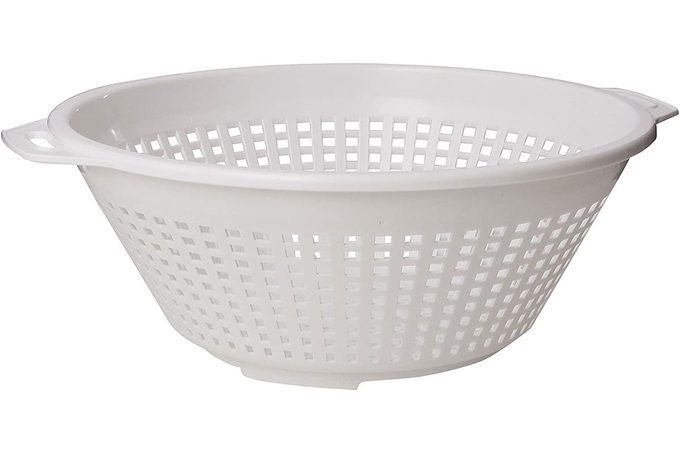Filling up a large pot with potting mix is expensive and makes for a really heavy planter. What’s more, the weight of so much soil can cause it to become compacted, which reduces drainage, waterlogs the soil and stunts root growth. So it’s a good idea to create a false bottom or place something lightweight in the bottom one-quarter to one-third of the pot to keep it easier to move, save on soil and maintain the health of your plant.
What To Know Before Adding Planter Filler
A few things to keep in mind before you fill:
Drainage holes are essential. They need to be large enough to allow water to readily flow out. Most store-bought planters will already have holes adequately sized for that container and some resin pots have optional knock out drainage holes.
If you choose a decorative planter without drainage holes, drill a hole between 3/8- and 5/8-inches. For ceramic planters, use a masonry drill bit, beginning with 1/4-inch then work up to 1/2-inch. Expert rose gardener Chris VanCleave usually uses a 1/2-inch drill bit for large pots more than six to seven inches and a 1/4-inch for smaller ones. Wear gloves and eye protection when drilling.
Small pots don’t require filler. Unless the drainage holes are larger than 1/2-inch diameter, very little potting mix is lost through the holes. So lining the pot bottom isn’t necessary, says Dr. Joe Willis, horticulture extension agent at the Louisiana State University Agriculture Center.
Try this easy fix for too-big drainage holes. If the drainage hole is larger than 1/2-inch, try covering the hole with a coffee filter to hold the soil in place until the root matrix forms and binds everything together. (Eventually, the paper will be broken down by microorganisms.)
Planter Filler: Empty Water Bottles or Milk Jugs
To keep larger planters (24 inches or more) easy to move, try filling them with lightweight, bulky items like capped empty water bottles or milk jugs. They take up space without adding weight. Plus, this is better than sending that plastic to the landfill! Be sure to tightly cap them so they don’t fill with water.
Planter Filler: Kitchen Colander

Recycle an old one from the kitchen or purchase an inexpensive new plastic colander. These make great planter inserts because they already have lots of small holes in them, perfect for drainage.
Planter Filler: Large Rocks
If you want to avoid soil compaction, but your planter is prone to toppling and you need extra weight, line the bottom with one to three-inch river rocks. Cover with a layer of landscaper’s cloth to hold the potting mix in place.
Planter Filler: Bubble Wrap
A lightweight inert material that won’t break down, many gardeners suggest using folded-up bubble wrap. Leave space around the edges for drainage.
Planter Filler: Pool Noodles
Pool noodles can be used in all sorts of nifty applications. And they can make a customizable filler for your planters. Cut them up into thin discs for smaller planters and larger chunks for larger planters. Plus, they come in several different sizes, making further customization a snap.
Planter Filler: Empty Plastic Pots
Place one of the old plastic garden pots you have laying around upside down. Just make sure it’s sturdy enough to support what you plant on top of it.
Planter Filler: Whole or Crushed Soda Cans
For another lightweight option that will add bulk, use whole empty soda cans (place facing down to avoid filling with water), or crushed cans if you have a large number of them. Be sure to wash them well to clean off any remaining food residue to avoid contamination.
Planter Filler: Bloem Ups a Daisy Planter Insert
Bloem Ups a Daisy Planter Inserts are plastic discs with drainage holes that function as a raised false bottom. They’re available in sizes from 10 to 18 inches in diameter.
Skip This: Gravel, Pebbles or Rocks
Sure, this is a popular step, but Willis says it’s best to skip it. Adding a layer of gravel or rocks to the bottom of a pot may actually reduce drainage rather than promote it.
As Willis explains, water doesn’t move easily from one media layer to another, even from a fine-textured material like potting mix to a denser material like gravel or rocks. So instead of the extra water draining into the gravel, the water will gather or “perch” in the bottom part of the soil until it becomes saturated, leaving no space for air to circulate.
Without good drainage and aeration, the plant roots can become severely stressed and more susceptible to plant diseases, and potentially drown and die.
Skip This: Styrofoam Packing Peanuts or Take-Out Boxes
Both have more drawbacks than benefits. Deep plant roots can grow down and into the Styrofoam, where they can become waterlogged, rot or die. And if the foam is biodegradable, once it breaks down in water and soil, it no longer provides any drainage benefit.
Skip This: Natural Materials
Many horticulturists advise against paper products such as newspaper and cardboard, or natural organic materials such as leaves, pine cones, sphagnum moss, wood chips and coconut fiber. These materials will break down in the soil, causing it and the plant to sink down into the pot, thereby defeating their function as fillers.
Article source here: What Should I Put In the Bottom of My Planter?


No comments:
Post a Comment